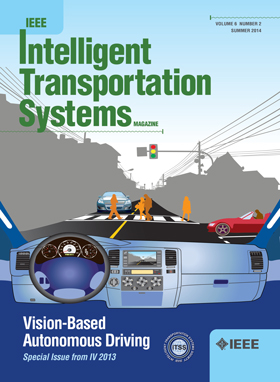HighlightNet: Learning Highlight-Guided Attention Network for Nighttime Vehicle Detection
IF 7.9
1区 工程技术
Q1 ENGINEERING, CIVIL
IEEE Transactions on Intelligent Transportation Systems
Pub Date : 2025-02-13
DOI:10.1109/TITS.2025.3539095
引用次数: 0
Abstract
Vehicle detection at night is a crucial task in Intelligent Transportation Systems. Due to the complex lighting environment, vehicle detection at night remains a challenging task. Headlights and taillights are essential cues to identify vehicles at night. However, existing methods struggle to effectively utilize the light information of the vehicle. This paper proposes a novel highlight-guided framework to identify vehicles, named HighlightNet, by utilizing both the illumination data from the vehicle lights and the reflective properties of vehicles. The framework combines vehicle detection and highlight area recognition via dual-branch joint learning. To ensure that both branches focus on the highlighted regions, Feature Similarity Awareness Attention (FSAA) is introduced to capture the common attention regions of different branches. Highlight Region Perception (HRP) is proposed to exclude streetlights and other reflective illuminations from the FSAA output, which generates a mask map capable of differentiating the foreground from the background of highlighted areas. It improves the allocation of feature weights and adaptively modifies the distribution within the dual-branch configuration. Furthermore, to address the severe pixel imbalance between the highlighted area and the background, Adaptive Spatial Balance (ASB) loss is introduced to allocate the attention towards prospective vehicle regions while diminishing the emphasis on background regions. Extensive experiments conducted on the BDD100K-Night dataset and a newly acquired dataset specifically designed for nighttime surveillance, called the NightVehicle dataset, demonstrate that HighlightNet outperforms the state-of-the-art methods for nighttime vehicle detection.HighlightNet:用于夜间车辆检测的学习型高光引导注意力网络
夜间车辆检测是智能交通系统中的一项重要任务。由于复杂的照明环境,夜间车辆检测仍然是一项具有挑战性的任务。前灯和尾灯是夜间识别车辆的重要线索。然而,现有的方法很难有效地利用车辆的光线信息。本文利用车灯照明数据和车辆反射特性,提出了一种新的高光引导车辆识别框架——HighlightNet。该框架通过双分支联合学习将车辆检测与高光区域识别相结合。为了确保两个分支都关注突出显示的区域,引入特征相似感知注意(Feature Similarity Awareness Attention, FSAA)来捕获不同分支的共同关注区域。高光区域感知(HRP)被提出用于从FSAA输出中排除路灯和其他反射照明,从而生成能够区分高光区域前景和背景的掩模图。它改进了特征权值的分配,并自适应地修改了双分支配置中的分布。此外,为了解决突出区域与背景之间严重的像素不平衡问题,引入了自适应空间平衡(ASB)损失,将注意力分配到前方车辆区域,同时减少对背景区域的重视。在bdd100k夜间数据集和一个专门为夜间监视设计的新数据集(称为夜间车辆数据集)上进行的大量实验表明,HighlightNet在夜间车辆检测方面优于最先进的方法。
本文章由计算机程序翻译,如有差异,请以英文原文为准。
求助全文
约1分钟内获得全文
求助全文
来源期刊

IEEE Transactions on Intelligent Transportation Systems
工程技术-工程:电子与电气
CiteScore
14.80
自引率
12.90%
发文量
1872
审稿时长
7.5 months
期刊介绍:
The theoretical, experimental and operational aspects of electrical and electronics engineering and information technologies as applied to Intelligent Transportation Systems (ITS). Intelligent Transportation Systems are defined as those systems utilizing synergistic technologies and systems engineering concepts to develop and improve transportation systems of all kinds. The scope of this interdisciplinary activity includes the promotion, consolidation and coordination of ITS technical activities among IEEE entities, and providing a focus for cooperative activities, both internally and externally.
 求助内容:
求助内容: 应助结果提醒方式:
应助结果提醒方式:


